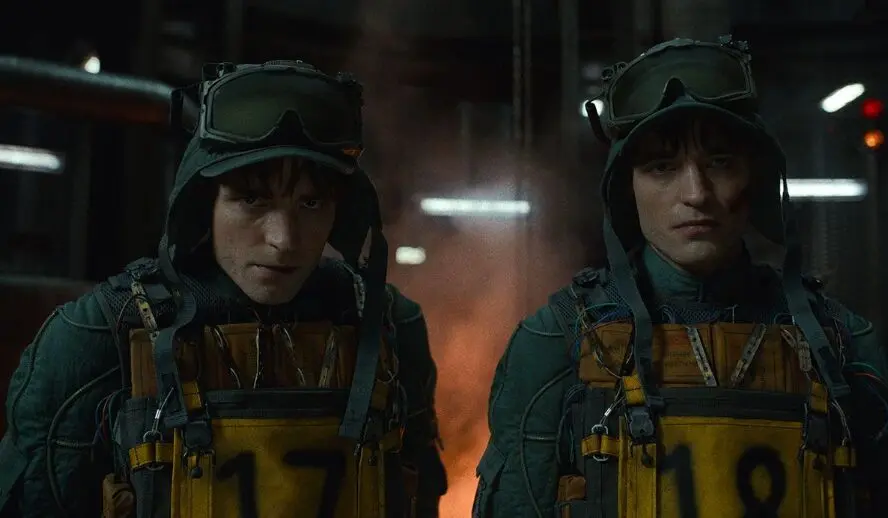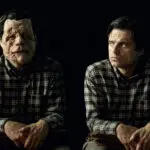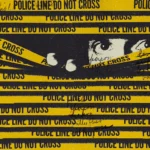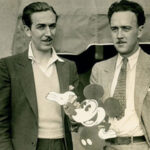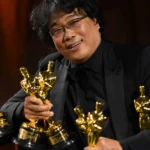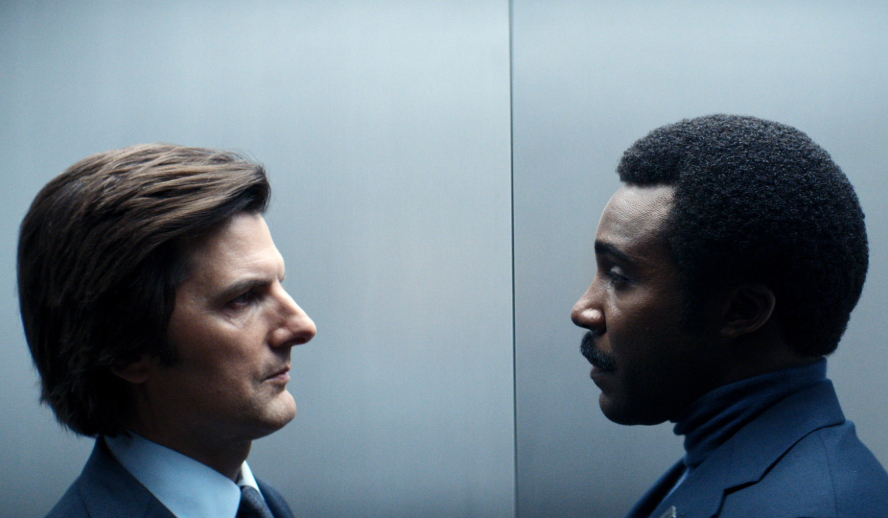
From ‘Severance’ to Bong Joon-ho’s ‘Mickey 17’, recent media has become obsessed with doppelgängers as a metaphor for fractured identity within a fast-moving, capitalist world. Seeing the slick body of Robert Pattinson fall lifelessly out of a septic printer over and over, to hearing the sickening elevator “ding” signaling the shift from outie to innie as characters enter the severed floor, both raise ethical questions about the efficacy of legal cloning as well as psychological questions about identity. These narratives explore how versions of the self—split by technology, labor, or memory—grapple with autonomy and existential dread. Doppelgängers of old, from dual Patricia Arquette’s in David Lynch’s ‘Lost Highway’ to the lime green-eyed Isabelle Adjani double in ‘Possession’, see these characters often represent the dark double, the evil twin, the repressed unconscious of female sexuality and carnal desire. As the 2020s continue, however, a key change has been made to the doppelgänger trope– the chosen, scientifically created double. Trauma, labor, and memory intersect in the latest doppelgänger cinema fodder, revealing anxieties about late-stage capitalism and automated workforces that seem to be just on the horizon.
Things to do:
- Subscribe to The Hollywood Insider’s YouTube Channel, by clicking here.
- Limited Time Offer – FREE Subscription to The Hollywood Insider
- Click here to read more on The Hollywood Insider’s vision, values and mission statement here – Media has the responsibility to better our world – The Hollywood Insider fully focuses on substance and meaningful entertainment, against gossip and scandal, by combining entertainment, education, and philanthropy.
The Doppelgänger and the Uncanny
Sigmund Freud’s groundbreaking 1919 essay, The Uncanny, describes the doppelgänger as belonging to “all that is terrible–to all that arouses dread and creeping horror.” It is the recognition of the familiar colliding with the grossly unfamiliar, the fear of the loss of bodily autonomy, of what is suppressed when encountering oneself. The term “doppelgänger” derives from a German word meaning “a ghostly counterpart of a living person.” Freud links the doppelgänger to childhood narcissism, or self-love, wherein the self is projected into multiple forms before ego development. In cinema, doppelgängers often offer insight into the increasingly narrow threshold between the self and the perception of the “other.”
Darren Aronofsky’s ‘Black Swan’ uses the doppelgänger trope to externalize the inner divide inside of the tortured ballerina Nina (Natalie Portman), who struggles to unleash her sexuality under the gaze of both her controlling mother (Barbara Hershey) and predatory instructor (Vincent Cassel). Nina is forced to confront her worst fears through her visualized double, the Black Swan, wherein Nina’s psychological breakdown sees her struggling to welcome her increasingly malevolent side. The most recent season of ‘Severance’ sees main character Mark (Adam Scott) subvert this trope; rather than fearing one of Mark’s doubles, both Mark Scout, his “outie” (outside of work) and his “innie” Mark S. (inside of work on the severed floor of Lumon Industries) are rooted for by the audience, exposing the unsettling reality of corporate control over identity.
WATCH THE TRAILER of the Film and the Revolution: ‘Can I Go Home Now?’
The Children Around the World Continue to Ask the question
Doppelgängers of the Past: Dream Logic and the Unconscious
An iconic and formative short film, Maya Deren’s ‘Meshes of the Afternoon’ employs surrealist dream logic to explore the unconscious. Maya Deren fractures her own body, both in atomizing shots of lips, arms, and feet, as well as in the three doppelgängers born throughout the film. The film externalizes the disjointed mental processes of the subconscious, showing the uncanny breakdown for self-recognition.
This tradition extends to the works of David Lynch, maybe the king of the doppelgänger, whose films Mulholland Drive’ and ‘Lost Highway’ borrow from surrealism to create an unsettling narrative of identity collapse. In ‘Possession,’ Ardzej Zuławski depicts the horrifying realization that one’s loved one has been replaced by an alien double. The origins of these doppelgängers are never explained, existing within the Freudian unconscious and dream logic key to their themes and construction. The doppelgänger became a figure of the existential crisis, representing both the hidden desires and the repressed fears of the individual, particularly women.
Related article: – Want GUARANTEED SUCCESS? Remove these ten words from your vocabulary| Transform your life INSTANTLY
Related article: A Tribute to the Career of Director Bong Joon-ho: The Cinematic Genius of the Century
A Shift in the Doppelgänger: From Dream Logic to Scientific Reality
Apple TV’s sci-fi hit ‘Severance,’ brain-child of Dan Erickson and helmed by Ben Stiller, coincides thematically with Oscar-winning Korean director Bong Joon-ho’s newest sci-fi comedy ‘Mickey 17,’ as they both examine the implications of technology that can create an agent yet enslaved worker through agent choice. The doppelgänger has moved away from surrealist, Lynchian horror toward science-fiction thrillers wherein the doppelgänger becomes real through corporate means, exploring the implications of self-duplication and selfhood. In ‘Severance,’ employees of mysterious company Lumon Industries undergo an irreversible brain procedure known colloquially as “severance” that splits their consciousness into “innie” and “outie” selves. This presents a new, modern doppelgänger paradox: if our identities are the only things we truly own, what happens when a company owns a version of us?
Related article: EVOLUTION: Every Ryan Gosling Role From 1995 to 2020, All Performances Exceptionally Poignant
Related article: EVOLUTION: Every Henry Cavill Role From 2001 to 2021, All Performances Exceptionally Poignant
Related article: Director Deep Dive: David Lynch and Finding Beauty in the Surreal – Hollywood Insider Are Inception’s Dreams Realistic? Yes, and in Accordance with Sigmund Freud’s Studies
‘Mickey 17,’ inspired by the 2022 science fiction novel ‘Mickey 7’ by Edward Ashton, takes the severance procedure further, introducing a cloning technology that allows a person’s consciousness to be uploaded into a new, printed body each time they die. Mickey 18, the accidentally created duplicate of the still-living Mickey 17, is not a traditional, haunting doppelgänger, but a manufactured double, raising questions about whether identity is tied to physical continuity. The film, from its cartoonishly colonial leader Kenneth Marshall (Mark Ruffalo) and his equally selfish wife Ylfa (Toni Collette), to the grossly repetitious reprinting of Mickey’s body, critiques late-stage capitalist labor structure by imagining a world where workers can be infinitely replaced, tortured with experiments, and brutally killed without a care, highlighting anxieties about automation and subsequent human expendability.
Both works use the scientific methods at the center of their narratives to examine the construction of self in the absence of memory. For Mark S., his outie’s grief-ridden posture, deep voice, disheveled hair, and darkened eyes are absent from his manicured, happy-go-lucky, innocent innie, who has no idea that his wife died in a car accident two years prior. For Helly R., after finding out that her outie is, in fact, the heir-apparent to Lumon Industries, a deeply complex question arises. Is it her lack of memory of her wealthy upbringing or exactly her subconscious corporate education that led her to become a revolutionary leader on the severed floor in the final moments of ‘Severance’ season 2? Because of a clumsy scientist, a reprinting of Mickey is faulty, resulting in a copy that is unlike the dopey Mickey we have become familiar with, instead becoming a jaded and angry version of our hero. Without the same memories, doppelgängers become, instead of an evil version of the “real,” a reflection of the way our memories, traumas, and experiences shape our being and understanding of labor and exploitation.
Related article: Understanding the Star Wars Timeline
Related article: A Tribute to Francis Ford Coppola: One of Cinema’s Unforgettable Directors | ‘Megalopolis’, ‘The Godfather’ & More
Related article: #metoo Revolution: Powerful Questions That Need Answers
Related article: FACT-CHECKED Series: Timothee Chalamet and 32 Facts about The Young Superstar
Related article: A Tribute to Ben Stiller: Respects Paid to Comedy Legend and Critically Acclaimed Writer-Director
As real-world technology advances, digital doppelgängers, or versions of ourselves that exist in online databases, are becoming more than just science fiction. AI-generated deep fakes, digital twins (wherein our health, engagement, sleep, and shopping data can craft a copy of our consciousness for the sake of algorithms), and corporate-controlled personas all blur the lines between selfhood and duplication. ‘Severance’ and ‘Mickey 17,’ as well as recent doppelgänger films like ‘The Substance’ and Jordan Peele’s ‘Us,’ portray a world where the self is not just split but commodified, often willingly.
One of the most defining shifts in modern doppelgänger narratives is the agency behind their creation. In classic horror and surrealist cinema, doubles emerge through fate, trauma, or dream logic. Their origins go unexplained, their presence only truly real to the protagonist. In contemporary storytelling, characters often choose to create their doppelgängers, with little mind to consent from their duplicate, the money earned and pain alleviated key to Mark Scout’s motivations in ‘Severance’ season 1 and Mickey’s initial motivation to become an “expendable” and flee Earth.
Related article: Top 10 South Park Characters | Who Makes the Cut? Kenny, Chef, Butters, Towelie, Eric?
Related article: In-Depth Analysis | The Unexpected Queerness of ‘Bob’s Burgers’: Why the Show is an Animated Ally
Related article: ‘The Substance’ – This Year’s Body Horror Experience Bound for Classic Status
The characters in ‘Severance’ sign up for the severance procedure. We find out the underlying reasons for two of our staple characters’ surgeries, the trauma caused by the death of Mark Scout’s wife, Gemma, and Dylan’s dissatisfaction with his middle-class life. They both relinquish control over a part of their identity for the promise of not just a work-life balance but to escape from their anguish. Mickey volunteers to be an “expendable,” knowing little of the implications of the procedure, opting to escape Earth because of financial pressure from loan sharks. As automation and artificial intelligence quickly advance, one must consider the motivations behind willingly fragmenting an identity for work. The fear of being replaced by a superior or disposable version of oneself has become increasingly relevant in an era where artificial intelligence and automated labor threaten human roles. Just as Mickey 17 faces existential dread, knowing that Mickey 18 will inevitably replace him, workers today grapple with the anxiety that a more efficient machine or algorithm could take their place. The doppelgänger, once a supernatural omen, has transformed into a symbol of technological displacement.
Experimental Bodies: ‘Severance’ and Cold Harbor, ‘Mickey 17’ and Revolt
The theme of human expendability is taken to an extreme in the latest season of ‘Severance’ Season 2, where Gemma (who is revealed to be alive, being experimented on below the severed floor) has been severed multiple times, each new variant being placed in moments of extreme pain or fear. Her experiment, named Cold Harbor, frames her existence as a test subject for corporate control over life and identity. Because Gemma is justified as a clone, an automated worker, she is treated as disposable—only narrowly escaping complete erasure when Mark discovers the truth about her false death. The revolution of the severed employees against their employers, particularly during the overtime contingency, mirrors the struggle for self-determination in ‘Mickey 17’.
Mickey 17 and 18 begin as rivals, filled with disgust and resentment for each other. Each clone sees the other as a corruption of their own existence, an unwelcome reminder of their lack of uniqueness. However, their rebellion is catalyzed by two shared forces: their love for their partner, Nasha (Naomi Ackie), and their recognition of the corruption of Marshall and Ylfa. Just as Mark’s innie fights for his outie’s wife, Gemma, as well as for his love, Helly, within Lumon’s walls, Mickey 17 and 18’s unity demonstrates how corporate, manufactured doppelgängers can reclaim their agency together.
Related article: In-Depth Analysis | The Unexpected Queerness of ‘Bob’s Burgers’: Why the Show is an Animated Ally
Related article: EVOLUTION: Every Chris Evans Role From 1997 to 2020, All Performances Exceptionally Poignant
Related article: Naomi Ackie Spills Secrets on ‘Blink Twice’ at Premiere
The Future of the Doppelgänger
The doppelgänger remains a potent symbol of contemporary anxieties. Upcoming projects such as Ryan Coogler’s ‘Sinners,’ starring Michael B. Jordan as identical twins, and ‘Twinless,’ a Dylan O’Brien-led grief film, suggest that this theme will continue to evolve, adapting to our fears of technological advancement and self-replication. As automation, AI, and cloning become more sophisticated, doppelgänger narratives will shift from dreamlike horror to urgent reflections on selfhood in the digital age. The question is no longer whether we fear our doubles but whether we are willing to create them ourselves.
By Leeann Remiker
Click here to read The Hollywood Insider’s CEO Pritan Ambroase’s love letter to Cinema, TV and Media. An excerpt from the love letter: The Hollywood Insider’s CEO/editor-in-chief Pritan Ambroase affirms, “We have the space and time for all your stories, no matter who/what/where you are. Media/Cinema/TV have a responsibility to better the world and The Hollywood Insider will continue to do so. Talent, diversity and authenticity matter in Cinema/TV, media and storytelling. In fact, I reckon that we should announce “talent-diversity-authenticity-storytelling-Cinema-Oscars-Academy-Awards” as synonyms of each other. We show respect to talent and stories regardless of their skin color, race, gender, sexuality, religion, nationality, etc., thus allowing authenticity into this system just by something as simple as accepting and showing respect to the human species’ factual diversity. We become greater just by respecting and appreciating talent in all its shapes, sizes, and forms. Award winners, which includes nominees, must be chosen on the greatness of their talent ALONE.
I am sure I am speaking for a multitude of Cinema lovers all over the world when I speak of the following sentiments that this medium of art has blessed me with. Cinema taught me about our world, at times in English and at times through the beautiful one-inch bar of subtitles. I learned from the stories in the global movies that we are all alike across all borders. Remember that one of the best symbols of many great civilizations and their prosperity has been the art they have left behind. This art can be in the form of paintings, sculptures, architecture, writings, inventions, etc. For our modern society, Cinema happens to be one of them. Cinema is more than just a form of entertainment, it is an integral part of society. I love the world uniting, be it for Cinema, TV, media, art, fashion, sport, etc. Please keep this going full speed.”
More Interesting Stories From The Hollywood Insider
– Want GUARANTEED SUCCESS? Remove these ten words from your vocabulary| Transform your life INSTANTLY
– A Tribute to Martin Scorsese: A Complete Analysis of the Life and Career of the Man Who Lives and Breathes Cinema
– Do you know the hidden messages in ‘Call Me By Your Name’? Find out behind the scenes facts in the full commentary and In-depth analysis of the cinematic masterpiece
– A Tribute To The Academy Awards: All Best Actor/Actress Speeches From The Beginning Of Oscars 1929-2019 | From Rami Malek, Leonardo DiCaprio To Denzel Washington, Halle Berry & Beyond | From Olivia Colman, Meryl Streep To Bette Davis & Beyond
– In the 32nd Year Of His Career, Keanu Reeves’ Face Continues To Reign After Launching Movies Earning Over $4.3 Billion In Total – “John Wick”, “Toy Story 4”, “Matrix”, And Many More
_____________________________________________________________________________

